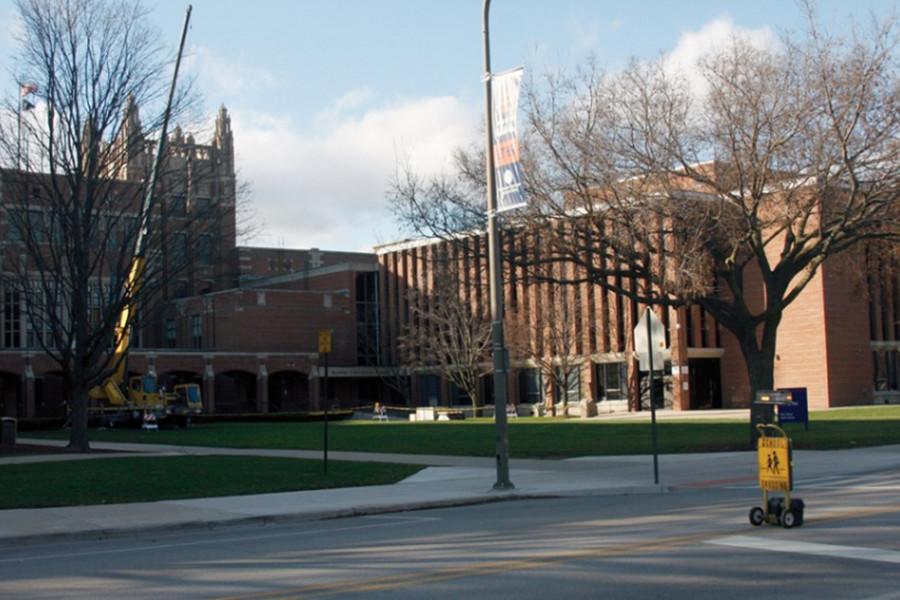Evanston school officials fear state cuts amid Illinois budget impasse
Daily file photo by Adnaan Zaffer
Evanston Township High School stands to lose millions under potential state remedies for a missing budget and building debt pile. ETHS and Evanston/Skokie School District 65 officials have attempted to cut excessive expenditures to prepare for the possible slashes to the districts’ state funding.
November 22, 2015
Illinois Budget Crisis
With the Illinois budget still in limbo, Evanston school officials fear potential solutions to relieve the state’s massive debt could cut millions of dollars from both districts.
Gov. Bruce Rauner and the state legislature failed to compromise on a new budget by the beginning of the fiscal year on July 1. Almost five months later, state legislators have yet to determine a budget while officials predict the state’s backlog will grow to $8.5 billion by the end of the year.
Although the uncertainty of the state budget has left some local social service organizations underfunded, both Evanston/Skokie School District 65 and District 202, which serves Evanston Township High School, are still receiving the majority of their state subsidies.
“Currently we’re some of the few institutions that are getting most of our money,” said Bill Stafford, ETHS’ chief financial officer. “For the most part, we’re getting our dollars as opposed to some other institutions, like higher ed.”
Although no clear solution has been brought to the table, officials from both ETHS and District 65 foresee several situations in which their funding could be cut significantly, such as a property tax freeze in fiscal years 2017 and 2018. Property taxes account for a major amount of both districts’ funding — 67 percent for District 65 and 85 percent for ETHS.
“If we had a property tax freeze, that would really be disastrous,” Stafford said. “Since we get most of our money from (property taxes), we would have to make really huge reductions.”
In the event of a property tax freeze — which legislators have been discussing for months — property tax rates across the state would be frozen at a set rate for two years while income taxes rose.
“If property taxes were frozen at current rates, and it kicked in two years from now, that would be about a $3 to 3.5 million hit on our budget,” District 65 superintendent Paul Goren told The Daily in September.
Another concern for both districts is a state funding reform bill — initially proposed in 2014 and then retooled and reintroduced the following year — that would redistribute funding from tax-wealthy districts such as Evanston to more tax-poor areas. Officials said the result would be a roughly $2.2 million deficit for ETHS and an approximately $6.6 million shortfall for District 65.
However, Goren said although the district has a generally high wealth index, Evanston schools serve students from a range of socioeconomic statuses, with 40 percent of District 65 students receiving free and reduced lunches.
“The concentration of poverty we face in the district is substantial,” he said.
Stafford said that a better solution than redistribution from district to district would be the state investing excess money from other areas into poorer school districts.
“Rearranging the dollars is a little bit like rearranging the deck chairs on the Titanic,” Stafford said. “Don’t, in the middle of a crisis, start taking money away from schools, as little as they give us in the first place.”
District 65 school board member and parent Jennifer Phillips said the district, which cut the equivalent of 29 full-time positions already earlier this year to cope with a projected deficit, has already begun to prepare itself for the worst.
Stafford recalled that ETHS was forced to make large reductions in the 1990s and late 2000s.
“(ETHS has) been through three or four budget crises, we went through the recession and had to make million dollar cuts,” Stafford said. “It’s harrowing and a problem, but it’s something we’ve done before.”
As both districts have weathered reductions in the past, however, District 202 superintendent Eric Witherspoon said ETHS has already trimmed virtually all its excess expenditures.
“Based on how we’ve already become leaner and found ways to save money and still continue offering the services and the education we offer our students, the challenge would become that now we would have to find even more ways to cut,” Witherspoon said.
Phillips emphasized that information and open communication between the district and its families is crucial moving forward.
“I hope the administration and the board are committed to making sure that parents, administrators, teachers and taxpayers have a really good understanding of the financial landscape and understand the choices and potentially trade-offs we will have to make,” she said.
Witherspoon said District 202 can ultimately find ways to bear the deficit, even if the cuts are deep.
“We can do it, but it’s going to be painful,” Witherspoon said. “Not only for our students, but for our community to see the kind of issue it’s going to create when we can’t provide the quality of education that this community wants and cherishes.”
Email: [email protected]
Twitter: @marissahpage


